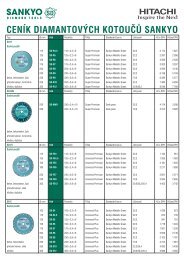warning - Hitachi
warning - Hitachi
warning - Hitachi
Sie wollen auch ein ePaper? Erhöhen Sie die Reichweite Ihrer Titel.
YUMPU macht aus Druck-PDFs automatisch weboptimierte ePaper, die Google liebt.
Fig.2-1<br />
Fig. 2-3<br />
Fig.1-1<br />
Fig. 2-2 Fig. 2-4<br />
3. Assembly procedures<br />
Assembling (Fig. 1-1)<br />
Connect the bit to drive shaft (1) of the power<br />
head and fix it with the snap pins (2) after<br />
setting the fixing pins (3) and washers (2 pcs.<br />
each).<br />
Selection of a Suitable Bit<br />
Choose an auger bit according to material to be<br />
bored.<br />
In case of ice boring, use an ice bit. When<br />
boring the earth, use one for earth boring.<br />
4. Operating procedures<br />
Fuel (Fig. 2-1)<br />
WARNING!<br />
The power auger is equipped with a twostroke<br />
engine. Always run the engine on<br />
fuel, which is mixed with oil.<br />
Provide good ventilation, when fueling or<br />
handling fuel.<br />
Fuel<br />
Always use branded 89 octane unleaded<br />
gasoline.<br />
Use genuine two-cycle oil or use a mix<br />
between 25:1 to 50:1, please consult the oil<br />
bottle for the ratio or HITACHI dealer .<br />
Only for the state of California at 50:1.<br />
If genuine oil is not available, use an antioxidant<br />
added quality oil expressly labeled for<br />
air-cooled 2-cycle engine use(JASO FC<br />
GRADE OIL or ISO EGC GRADE). Do not use<br />
BIA or TCW (2-stroke water-cooling type)<br />
mixed oil.<br />
Never use multi-grade oil (10 W/30) or waste<br />
oil.<br />
Always mix fuel and oil in a separate clean<br />
container.<br />
Always start by filling half the amount of fuel,<br />
which is to be used. Then add the whole<br />
amount of oil. Mix (shake) the fuel mixture. Add<br />
the remaining amount of fuel.<br />
Mix (shake) the fuel-mix thoroughly before filling<br />
the fuel tank.<br />
Fueling<br />
WARNING!<br />
Always shut off the engine before refueling.<br />
Slowly open the fuel tank, when filling up<br />
with fuel, so that possible over-pressure<br />
disappears.<br />
Tighten the fuel cap carefully, after fueling.<br />
Always move the unit at least 3 m (10 ft.)<br />
from the fueling area before starting.<br />
Before fueling, clean the tank cap area carefully,<br />
to ensure that no dirt falls into the tank. Make<br />
sure that the fuel is well mixed by shaking the<br />
container, before fueling.<br />
Starting<br />
1. Set ignition switch (1) to ON position.<br />
(Fig. 2-2)<br />
* Push priming bulb (4) several times so that<br />
fuel flows through the bulb or return pipe. (If<br />
so equipped) (Fig. 2-3)<br />
2. If throttle lock (3) is equipped, pull the<br />
throttle trigger (2) and keep pushing the<br />
throttle lock (3), then slowly release the<br />
lever to be locked. (Fig. 2-2)<br />
3. Set choke lever to CLOSED position.<br />
(Fig. 2-3)<br />
4. Pull recoil starter briskly, taking care to keep<br />
the handle in your grasp and not allowing it<br />
to snap back. (Fig. 2-4)<br />
5. When you hear the engine want to start,<br />
return choke lever to RUN position (open).<br />
Then pull recoil starter briskly again.<br />
(Fig. 2-3)<br />
NOTE!<br />
If engine does not start, repeat procedures from<br />
2 to 5.<br />
6. After starting engine, allow the engine about<br />
2-3 minutes to warm up before subjecting it<br />
to any load.<br />
GB-6














